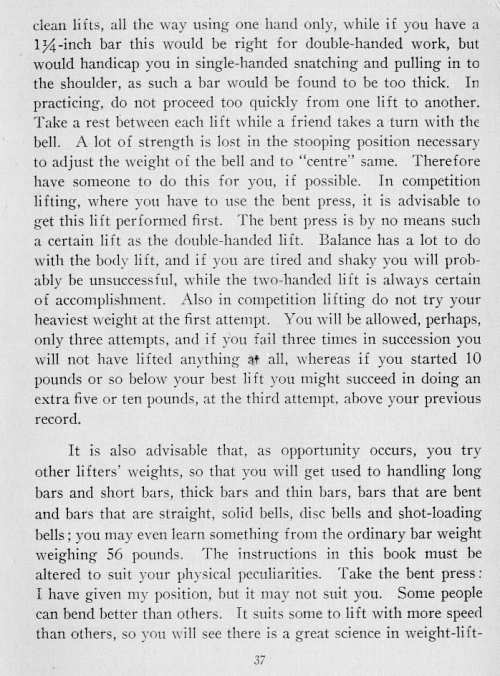dpp37

clean li lis, all the way using one band only, while if you have a lj4-inch bar tliis would be right for double-handed work, bul would handicap you in single-handed snatching and pulling in to the shoulder, as such a bar would be found to be too thick. In practicing. do not proceed too c|uickły front one lift to another. Take a rest between each lift while a friend takes a tum with thc beli. A lot of strength is lost in the stooping position necossary to adjust the wcight of the beli and to “eentre" same. Therefore have someone to do this for you, if possible. In compctition lifting, where you have t<» use the bent press, it is advisable to get this lift pcrformcd first. The bent press is by no means such a ccrtain lift as ihe double-handcd lift. Balance has a lot to do with the body lift. and if you are tired and shaky you will prob-ably be unsuccessiul, while the two-handed lift is alw.ays certain of accomplishment. Also in competition lifting do not try your heaviest wcight at the first attetnpt. Vou w ill l>e allowed, perhaps, only three attempts, and if you fail three tinics in succession you will not have liftcd anything at all, whereas if you started 10 pounds or so below' your best lift you tnight succeed in doing an cxtra five or ten pounds, at the third attempt, ahovc your previous record.
It is also advisable that. as opportuttity occurs, you try other lifters' weights, so that you will get used to handling long bars and short burs, thick bars and tliin bars, bars that are bent and bars that are straight, solid helis, disc helis and shot-loading l>ells: you may evcn learn something from the ordinary bar weight weighing 56 pounds. The instructions in this book must l>e altered to suit your physical j>cćuliarities. Take the bent press: I have given my positioit. but it may not suit you. Sonie people can bend better tlian others. It suits sonie to lift with morę speed than others, so you w ill see there is a great science in weight-lift-
Wyszukiwarka
Podobne podstrony:
Download BIOTECNOLOGĺA AMBIENTAL PDF eBooks Free cutter cut all the way through the clay,
system 100 100 back (Fig. 82). Exhaling fully, twist slowly all the way round to the right, changing
Jingle Bells2 Jin - gle bells! 3 1 Jin - gle bells!i i........-a I Jin - gle all 2 1 the way! 3
David Drake All the Way to the Gallows (B) "Okay, the name Lucrezia Borgia doesn’t immediatel
David Drake All the Way to the Gallows (B) "Okay, the name Lucrezia Borgia doesn’t immediatel
David Drake All the Way to the Gallows (T) DAVID DRAKĘ
base Base 67.0 1.5 Base plywood doesn t go all the way to the end so that base can be cut
base Base 1.5 Base plywood doesrYt go all the way to the end so that base can be cut from
frame frontrail Frame front raił box is all the way to the left. Transverse grain direction
Case of Yick Wo vs. Hopkins Read the facts regarding a case he took all the way to the Supreme Conrt
34 3 http ://groups. msn. com, linę (#2 scriptDragonfly Touch, lift, touch, lift all the way to tip
Using Morę Than one Table The pet table keeps track of which pets you have. If you want to record ot
Verifying Package Integrity Using MD5 Checksums or GnuPG After you have downloaded the MySQL package
56572 musc dev049 Ho w the Muscles Increase in Size Sr If you have had nny experience with exerrisin
więcej podobnych podstron